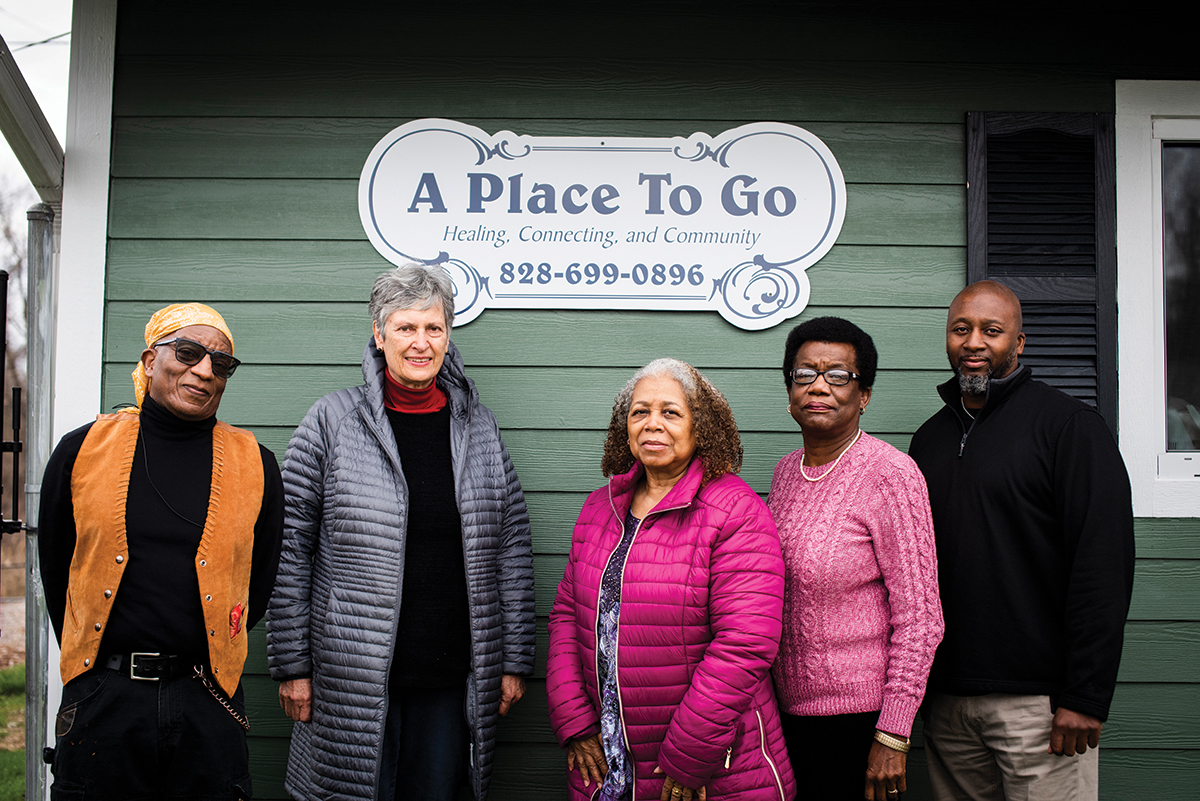Community group documents the untold past of Henderson County

Black History Research Committee members include local activists, business owners, and long-time residents. L-R: educator/storyteller Ronnie Pepper, Suzanne Hale, Shirley Davidson, Melinda Pilgrim Lowrance (President of the Henderson County Chapter NAACP), and U.S. Army veteran Terry Young. Pepper and Lowrance are both alumni of Ninth Avenue School.
Portrait by Karin Strickland
As its name implies, the Carl Sandburg Home National Historic Site focuses on the life of its most famous resident, the populist poet who occupied the big, white house with his family from 1947 to 1967. But that’s an incomplete picture of the estate’s past, according to UNC-Chapel Hill history professors David E. Whisnant and Anne Mitchell Whisnant.
Last year, the Whisnants authored the study Black Lives and Whitened Stories: From the Lowcountry to the Mountains, commissioned by the National Park Service, which administers “Connemara,” the nickname given to the property by industrialist Ellison Adger Smyth during his ownership in the first half of the 20th century. (The house was built with slave labor in 1838.)

1962 photo of a Ninth Avenue School science class.
Only highlighting the narrow timeline of Sandburg’s happy retirement years at Connemara “has silenced earlier histories,” write the Whisnants, “during which enslaved and, later, free Black Americans lived and labored at [the site]” — now a popular tourist attraction.
Those histories include that of James Fisher, a valet and chauffeur who lived on the estate during the Smyth years. But according to Ronnie Pepper, local storyteller and president of Henderson County’s Black History Research Committee, such an unbalanced view of local history extends far beyond the pine-needle paths and dewy hayfields of Connemara.
“The history of the entire United States is told from a white perspective,” says Pepper. “You never get the complete story.”
The Black History Research Committee seeks to change that. The Committee first organized in 1986, established by local residents including John Marable — former principal of the Ninth Avenue School and an innovative educator who implemented “The Tigers” football team and a marching band there — and hair stylist-turned-activist Kathleen Featherstone Williams.
Members compiled newspaper articles, oral histories, and photos that told the experience of local African Americans. In 1996, this information was published in a book by Gary Franklin Greene, A Brief History of the Black Presence in Henderson County. However, just as the project gained steam, older members began to pass away, and efforts came to an emphatic halt.

1962 photo of Ninth Avenue School students in the library preparing for an academic competition. Standing, L to R: Frank Wilson, Harry Wilson. Seated L to R: Jannet Norman, Cornelius Hunt and Johnny Young.
BAKER-BARBER COLLECTION. COMMUNITY FOUNDATION OF HENDERSON COUNTY. HENDERSON COUNTY PUBLIC LIBRARY.
The Committee sat dormant for the next two decades. But Pepper — who was never an official member but had offered his knowledge of the area when needed — didn’t forget about its mission. “It was always in the back of my mind,” says Pepper. “The embers died down, but the fire never went out.”
With hopes of making the now out-of-print and hard-to-find Black Presence book more accessible, Pepper decided to resurrect the Committee in 2020.
So far, the group’s primary initiative has been the launch of blackhistories.org. The website, funded using a Racial Equity Community Grant from the Dogwood Health Trust, digitizes passages from the 1996 text. It also compiles information from local historians, photographs from the Baker-Barber Collection, articles from publications including The Urban News, and current research about important residents of Henderson County’s past, including excerpts from the Whisnants’ recent study that highlights James Fisher and other Connemara workers.
Scrolling through the Committee’s website, it’s easy to get lost in the sepia-toned accounts of yesteryear. Stories include that of Brooklyn, a now invisible community that once spanned the upper side of Seventh Avenue to Ashe Street in Hendersonville, where emancipated slaves first settled in shotgun-style houses. Generations later, it was a place where teenagers sipped Coca-Cola at a juke joint called the Homer Davis Café and kids cooled off in a small, clear brook — likely the neighborhood’s namesake. But all was lost when urban renewal came to town in 1960.

1948 photo of Mrs. Mims’ Home Economics class at the Ninth Avenue School.
BAKER-BARBER COLLECTION. COMMUNITY FOUNDATION OF HENDERSON COUNTY. HENDERSON COUNTY PUBLIC LIBRARY.
There are many accounts of the Ninth Avenue School, which served African American students from Henderson, Polk, and Transylvania counties from 1951 to 1965. Pepper is an alumnus of the school who speaks about the experience to local schoolchildren every year on or around February 18, proclaimed Ninth Avenue School Day by Henderson County 15 years ago.
Despite working with a lack of resources, students and teachers made the most out of what they had, according to accounts that include the recollections of home-economics teacher Mary Mims. In Black Presence, she relates: “We might think that it was difficult then, but it didn’t hurt that much because we had a lot of togetherness.”
Black community members such as Theo Mackie, whose family first came to Hendersonville from Florida as migrant workers in the 1960s, and Walter Allman, who fired up the furnace at Hendersonville High School at 5am each day, also have their say.

Valet and chauffeur James Fisher at Connemara (Carl Sandburg National Historic Site) when it was owned by Ellison Adger Smyth.
From the Ballard Family Photograph Collection at Carl Sandburg Home National Historic Site
Personal accounts like these bring the past to life, says Suzanne Hale, the Committee’s secretary. “Stories about individuals are so important because they don’t usually end up in the history books,” says Hale. “There’s always more to history than what first meets the eye.”
The Committee’s hope moving forward is to collect more oral histories before stories are lost. But the other hope is to address prejudice head-on.
“The problems our world is facing today aren’t going to be solved by policies or laws,” says Pepper. “No, we as individuals have to un-believe the ideas we were conditioned to believe about other groups of people. We have to see and understand their perspective — their world.”
At Connemara, visitors will begin to understand the world of Fisher and his coworkers as NPS staff revamp house tours to include information about the estate’s pre-Sandburg past. They will also erect several outdoor exhibit panels in front of structures once used by Black workers. The goal is to tell a fuller and more honest story — one that has yet to be told in history books.
On Saturday, Feb. 12, from 2-3pm, Henderson County’s Black History Research Committee will host “Celebrating Ninth Avenue School and Its Alumni,” a free program that looks at the importance of the Ninth Avenue School and its role during segregation. The event will be held at the Henderson County Main Branch Library (301 Washington St.). For more information, visit blackhistories.org.



